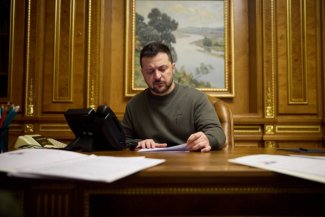Discussions on mobilisation in Ukraine. Day 666 of the war

Between 19 and 22 December positional clashes continued along the entire front, but they did not significantly change the positions of either of the armies. The most intense clashes took place in the areas of Bakhmut, Avdiivka and Marinka. South of the latter, in and around Novomykhailivka, the Russians attempted to occupy the enemy’s positions, which are forming a wedge about 4 km deep into their group.
On the night of 19–20 December, the invaders attacked Ukraine with 19 Shahed 131/136 drones. According to a communiqué from the Ukrainian Air Force Command, anti-aircraft defences shot down 18 of them. Once again, the invaders also used S-300 anti-aircraft missiles, attacking civilian facilities located in the Kharkiv oblast. According to the local administration, two missiles fell on the Kharkiv public transport depot and another two on the buildings of the village of Odradne in the region of Kupyansk, without causing any loss of life. The following night, the Russians again attacked with Shahed 131/136 drones; nevertheless, the anti-aircraft defence proved highly effective, shooting down 34 of the 35 drones used. On the evening of 21 December, there was also a successful rocket attack on Zaporizhzhia, but the Ukrainian administration did not give any information on the type of rockets used or the losses incurred. On the night of 21–22 December, the invaders used 28 Shahed 131/136 drones, 24 of which were shot down by anti-aircraft defences. The main attacks were directed at Kherson, Mykolaiv and Odesa oblasts, where some of the drones hit granaries and other unspecified infrastructure facilities.
On the night of 19–20 December, Ukrainians attacked two facilities located in Crimea: the Federal Security Service’s communications post at Sonyachnohirske near Alushta and the military space communications centre at Vityne near Yevpatoria. They probably used Storm Shadow/SCALP missiles, possibly in combination with drones. However, there is a lack of detailed and reliable reports assessing the scale of the losses.
On 21 December, Helsinki announced the 21st package of military aid to Kyiv, amounting to €106 million. This brought the total military support from Finland to the equivalent of €1.6 billion. On the same day, the Canadian arms company Roshel announced that it had produced its 1000th Senator-type armoured vehicle (MRAP) for Ukraine since Russia launched its invasion in 2022. This message is inconsistent with the official information: to date, Canada and the US have pledged deliveries of only 398 such vehicles.
Also on 21 December, the German government released new figures for military support to Kyiv. The total deliveries of armaments and military equipment from Germany have so far amounted to €5.97 billion (€1.63 billion in 2022 and €4.34 billion the next year).
On 19 December President Volodymyr Zelenski insisted that he would not sign a law allowing for the compulsory mobilisation of women. He also stipulated that he would only take the decision to reduce the mobilisation age from 27 to 25 after considering “all the arguments”. He admitted that the military command had made a proposal to mobilise up to half a million men, but – in addition to risking the lives of soldiers – such a step would entail the expenditure of 500 billion hryvnias (more than $13 billion). He had therefore asked the prime minister and the finance ministry to assess whether it would be possible to incur such costs. According to Zelensky, it is imperative to plan the mobilisation precisely and define the principles for the rotation of soldiers at the front. When journalists asked whether he intended to dismiss Commander-in-Chief General Valerii Zaluzhnyi, the president replied that he “maintains a working relationship with him” and plans to continue working with him.
On 21 December, in an interview with the German daily Bild, Ukraine’s defence minister Rustem Umierov announced that all Ukrainian men between the ages of 25 and 60 – including those residing outside the country – should receive summonses to report to military commissions, and that evading registration would be a punishable offence. A day later, the defence ministry issued a communiqué stating that Umierov had merely summoned all able-bodied men to join the army, and that penalties for non-appearance were not currently being considered.
On 20 December the minister of strategic industry Oleksandr Kamyshyn insisted that Ukraine’s defence industry would be able to produce more than 10,000 medium-range strike drones and more than 1000 long-range drones next year. He added that the production of small FPV drones had reached 50,000 in December this year. A day earlier, President Zelensky declared that the armed forces would receive one million drones of various types in 2024.
On 20 December, a representative of the State Border Service in Lviv, Ihor Matviychuk, stated that 6000 men of conscription age, around 200 of whom are truck drivers, have been crossing the country’s western border every day. Matviychuk said there has been a recent increase in the number of men marrying mothers with many children or caring for disabled people, which allows them to leave the country. He added that a large percentage of those leaving have obtained certificates of unfitness for military service. In September this year, NGL.media reported that more than 2000 men had crossed the border with permits from the Lviv regional administration intended for truck drivers. Most of them did not return to Ukraine.
On 21 December, in an interview with the Politico website, the head of the Security Service of Ukraine, Vasyl Malyuk, asserted that the institution he heads is carrying out a number of special spot operations to weaken the enemy’s military potential. The operations against the Black Sea Fleet using Sea Baby naval drones are of particular importance.
On the same day, digital transformation minister Mykhailo Fyodorov stated that Ukraine had received another 5000 Starlink terminals from Poland to provide communication in the frontline zone. He added that about 47,000 terminals of this type are in operation in the country today, 19,500 of which had been donated by Poland.
Commentary
- The statements by President Zelensky and the head of the defence ministry on how further mobilisation should be implemented confirm that this is a thorny issue, for both social and financial reasons. The military authorities have been showing their determination to support the idea of extensive mobilisation, as they see no other way to fill personnel shortages and restore the military units that have suffered heavy losses at the front. The president, on the other hand, fears the public’s reaction to tightening up compulsory mobilisation, so he is putting off taking a final decision, suggesting that it can only be taken by parliament, after the provision of funding from the government.





